It is significant. It is a significant day for our city. It’s a significant decision. It gives us the strategy and policy and direction that we’ve been asking for. – Richard Hills, Chair of the Auckland Council Environment and Climate Change Committee
On Thursday last week, Auckland Council adopted the Transport Emissions Reductions Pathway (TERP). We explained last week why we think it is an excellent piece of work.

The TERP means that significant progress on transport transformation could be obvious within just a couple of years. In turn, this could spur action in hundreds of cities still struggling with the politics of change, and suffering from the same kinds of car dependent transport planning problems that we have. What a powerful and uplifting tonic in the midst of a crisis!
This post lays out why we are optimistic it will be implemented.
We understand the scepticism
Some of our readers are questioning our optimism, and we’re not surprised. I’ve collated some of the many False Starts, here.

Any one of these moments could and should have marked a turning point for Auckland’s transport system. We know that the same conservative approach that prevented these opportunities from being harnessed remains a barrier to progress.
The dinosaurs in the organisations are now practised in dodging the transformative direction given, but those trying to steer us to a healthier system are also more savvy. All the false starts have contributed richly to the evidence base about what needs to change and whose thinking is out of date.
We are under no illusions; this will require a strength in leadership and governance we’ve not yet seen. But here’s why we think the landscape has changed.
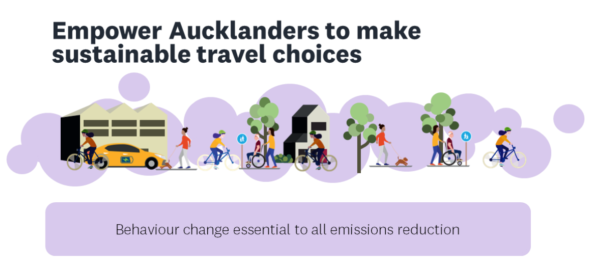
Money Talks
Of course the TERP is necessary climate action. Of course it will make our city an excellent place to live. Of course it will save lives.
Unfortunately, money still holds power.
So it’s lucky, then, that the TERP makes excellent economic and business sense. Creating a safe and sustainable system has always been wise from an investment point of view, but those wanting to exploit people and environment for short-term gains have worked hard to deny this. Now, we are finally getting official estimates of the benefits of change for Auckland and NZ. The Council is still crunching the final numbers, but the Chief Economist listed some
material and significant co-benefits:
- Health gains from improved air quality and greater uptake of active modes
- Environmental – improvements to air quality, water quality and biodiversity
- Economic, in terms of a more compact city through land use change, and more transit oriented development. You would hope for a more productive urban environment as a result of that…
He spoke of the scale of the benefits of the reduction in transport emissions and that:
alongside there are a couple of very large categories of co-benefits. The evidence is pointing to them together being as substantial as the transport emission reductions benefits
Advocate Tim Adriaansen has calculated just some of the wider economic benefits to Aucklanders of the TERP, using the following orthodox sources:
- Ministry of Transport Domestic Transport Costs and Charges
- Ministry for the Environment HAPINZ 3.0 report
- The AA’s figures on the cost of car ownership
Tim’s partial analysis indicates the economic benefits are $11 billion per annum, so it’s going to be interesting to see what the official figure will be.
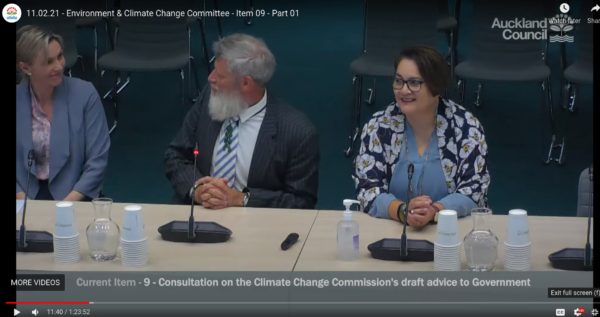
Officers also referenced the Climate Change Commission’s work:
The cost of inaction were around 2 to 3% of GDP and the costs of action are 1%. Of course, that’s nationwide; it might look a bit different for Auckland. But that gives an idea of the relative benefits vs costs.
Many leaders in the business community understand this.

Sir Stephen Tindall wrote in the NZ Herald on Thursday (sorry about the paywall)
Much of the scoping for emissions solutions for the business sector has already been progressed – for example, in 2020 the Sustainable Business Council prepared a paper on how to achieve a low-carbon freight pathway…
We now have the TERP which provides a detailed and cohesive set of practical steps and gives Aucklanders many more choices to reduce emissions and improve our quality of life. The TERP is supported by substantive data and rapidly evolving technological solutions for business to play its part in reducing transport emissions from the movement of freight.
Importantly, decarbonising Auckland’s Road freight emissions by 45 per cent will see an increase in economic activity and improve all outcomes at once: health, accessibility, environment and safety, as well as making the system more efficient so businesses can thrive now and in the future.
That makes perfect business sense, right?
The ugliest excuse against keeping our children safe from harm is that “tradeoffs” are needed to be “good for business”. Yet this excuse for continuing to take human sacrifices was never even true.

The AT Board is serious
Auckland Transport sent a large contingent to the meeting on Thursday:
- The Board Chair, Deputy Chair (online) and the most climate-savvy Board Member
- The acting CEO, Executive GM Planning and Investment, and at least two members of the AT Sustainability team.
This was a practical way to support the TERP, as some of these people spoke and answered questions. But it was also symbolic; the unaccustomed size (and power) of the contingent was a deliberate indication to the Councillors that the AT Board understood the scale of the work the organisation had ahead, plus an acknowledgement of the increased importance of the AT Sustainability Team.
Council is serious
Councillor Darby, who chaired the Planning Committee when it endorsed the high-emissions Regional Land Transport Plan, was clearly relieved and motivated. He asked the officers about:
the Auckland Transport Alignment Project, which has in some ways usurped the RLTP, and we need to address that. That’s a non-statutory, high-level agreement, with our government partner, and their agencies, being KiwiRail, Waka Kotahi, Treasury and so on. At that level, where the partner is not acting consistently with our transport emissions reductions pathway, how is that going to be treated? Do we send up a red flag, a showstopper, at that point? I’m just trying to get a sense of the future, here. Do we do that, and say, we cannot progress this agreement because we’ve got a red flag, because you are calling us to act contrary to the transport emissions reductions pathway? I just want to get a sense of how that’s going to work.

The Council officers replied:
The signals from Government at this stage are really good, because Government has its own emissions reductions plan, it’s got targets for the country… But yes, if it turns out in these processes that we are maybe not on exactly the same path, I think that is a red flag, probably. And that is probably a process that is a political process, and that the new council will take on.
And:
note that the last ATAP didn’t have the benefit of either the TERP, or the government’s own Emissions Reductions Plan, so there was no explicit direction, nor explicit prioritisation around emissions reduction or around VKT reduction and indeed around equity, like there is now or hopefully will be, after this meeting today.
Essentially, setting good strategy enables good decision-making. Later, Darby said:
I would suggest at the end of today, Chief of Strategy, we need to send a message to every corner of this Council that this pathway is now in place, and then for the very first Council meeting that convenes maybe late this year or early next year, there needs to be a report signalling that the Regional Land Transport Plan shall be immediately refreshed, and that process be put underway.
Those Councillors who were online for the meeting included all four who voted against adopting the TERP: Newman, Walker, Stewart and Sayers. Perhaps they would have tempered their speeches if they’d been present to feel the positivity in the room. Opposing a plan that would deliver for the people of Auckland (in safety, health, equity, affordability and a stable climate) came across very badly; their particular words made it much worse.
The Council subject experts were able to answer difficult and detailed questions, but what was noticeable was that this extended to the General Manager, Auckland Plan Strategy and Research. Normally someone at that level would give introductory speeches and then pass over to the people who’d done the work. It was indicative of the priority Council gave to this work that this manager was clearly fully up to speed.
This incredible effort was a far better use of resources than all the money burnt up doing business cases. It was very promising that the team showed equal measures of ambition, administrative pragmatism and political understanding.
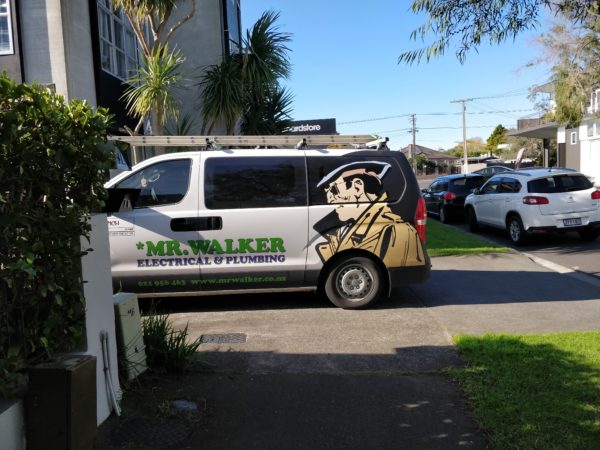
First Steps
Auckland Council and the AT Board’s commitment needs to be matched with immediate and visible action of actions the public are calling for – like getting vehicles off the footpath. This would restore trust and build public enthusiasm.
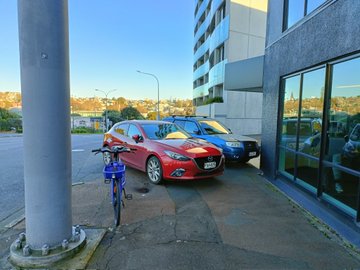
I linked to a page of “False Starts” earlier. These democratically established plans and strategies already exist; we just need to stop ignoring them. The 2015 Parking Strategy is an obvious example.
For AT management to respond proactively, they will need to accept the many failings that led to the need for the TERP in the first place. To help, it might be useful to shift gear, and get right down into the nitty gritty, by putting some projects under the microscope. A critique and redesign of a few projects over the next few months, to better serve sustainable transport modes, would highlight the immediate changes to priorities required for all projects. Currently it is rife, even in the safety projects, for traffic flow to be prioritised over safety and the misinformed assumptions of businesses to be elevated over the needs of children. Also, a lot of money for safety projects could be released immediately by reducing temporary traffic management and speeding projects up, by allowing more disruption to vehicle flow over a shorter period.
Could they start by:
- inviting all staff to come forward with ideas?
- inviting advocates to talk with Board members?
- creating an anonymous forum for anyone in the sector to help alert them to ongoing problems?
One focus area for Council management could be to prepare some democracy skills training workshops for the incoming Councillors and Local Board members. There’s a need to clarify:
- The duties of elected members are to serve current and future generations, not to win over the vocal minority resistance. No one holds a power of veto over changes needed for safety and healthy. Demonstration is the best way to inform, and leadership involves finding ways to explain this.
- Demand for safe travel options is large, longstanding, and unsatisfied. Meeting that demand by providing a full range of safe options for walking and cycling would take us a long way towards achieving our goals already. Any question of whether Aucklanders will “actually respond” to the provision of better options is misplaced (and should be recognised as stalling action).
Nothing short of a full change of regime will achieve the emissions reductions targets. But also, none of these changes are radical, and all of them are possible.
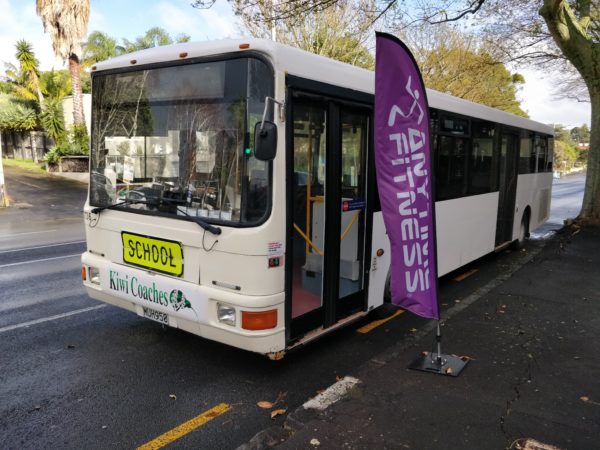

 Processing...
Processing...
Would be nice to see some immediate progress from AT, an acknowledgement that there is no time for big projects and that they need to roll out cheap changes quickly.
I’d like to see some progress on Dominion Road now we know that LRT is a long way away and is going to be underground. How about having Dominion and Sandringham road buses go via Ian McKinnon Drive and Upper Queen Street to take pressure off Symonds Street and to make the route quicker. And at least some streetscape upgrades on Dominion, it is overdue by about 30 years. All coupled with electric buses, perhaps with some kind of charging mechanism on route.
They won’t improve buses. That would undermine the justification for light rail.
Dominion Road buses have gone via Upper Queen St/Ian McKinnon, at peak times anyway before now. I presume they are mostly routed via Symonds st is more passengers to pick up going that way.
Yes and those morning express buses are much quicker. People that need to go elsewhere could transfer at k road or similar. Why would the bus need to take a different route than surface LR would?
Can you really say Council is serious when the same day this came out they notified their intensification plan changes which quite intentionally do not align with the TERP? Notable that two of the more prominent Councillors talking about climate change are also the biggest supports of preventing intensification in the most accessible areas of our City.
The TERP was an easy thing to vote for as it has no statutory function. Even more so considering one of the key actions to achieve it (switching private vehicles to EVs) has nothing to do with Council functions/ influence.
Things will only happen if they have no political backlash associated. Like signing plans and declarations.
Isn’t TERP just 80 more pages of word salad from Auckland Council. It doesn’t change the AUP, it doesn’t constrain any decisions they make and it doesn’t limit choices the public make.
What did you do to deal with climate change? “I wrote another report.”
It’s better than “I helped a mall force it’s competitors to oversupply parking they didn’t need” or “I stopped a competitor supermarket from setting up in a convenient accessible location in the environment court”.
No it was parking they didn’t want not parking they didn’t need.
That list of false starts is really confronting. A whole decade of lost momentum, and forfeited opportunities to develop staff expertise and grow public confidence.
Hopefully the new CEO can rise to the task and cut through the sticky web of delay. It’s a relief that the Board finally seems to be on board. But no more time to waste.
The picture “Not a parking spot” shows two private cars on the right. Presumably the trade vehicle would park on the street if the space was available.
One of the tests of greater efficiency by say 2030 will be if it is much easier for ‘working vehicles’ (powered by battery or hydrogen) to get around. But how many weekday public transport commuter users will still have cars they leave in the street Monday to Friday, ready for “weekend fun” and tasks.
One of the tasks is supermarket shopping. Outside a few central city zones the basic supermarket , Pak’N Save etc is predicated on people using private vehicles making one big shop with all their bags and boxes going home in the car.
I wonder how many suburbanites have even considered changing their shopping pattern.
Supermarkets are a peculiar case.
A main factor is cost. Despite the cost of driving a car, it is significantly cheaper to drive to a Pak’n’Save than to shop more locally. The fact that they don’t charge for parking is irrelevant because you pay for that anyway through the cost of your groceries.
Even if that is not a factor, a lot of homes are so far from a supermarket that any other shopping pattern becomes very cumbersome.
A few interesting points there, Jeremy.
“Presumably the trade vehicle would park on the street if the space was available.” The trade vehicle was in Raymond St and there were ample parking spaces available on the street. Clearly some commercial drivers tend to comply with the rules, and some don’t, but enforcement has an enormous influence on the proportion who do comply. See this research: https://twitter.com/DavidZipper/status/1556629160872685568?t=Tm__MjoSaO6Wlp-pLobPew&s=09
New study explores why US parcel delivery drivers so often block car lanes, bike lanes, crosswalks, etc. Conclusion: “[Delivery] drivers reported that parking enforcement personnel rarely issued tickets or other reprimands.” https://doi.org/10.1016/j.tranpol.2022.07.013
AT need to enforce and their lack of enforcement will have contributed to DSI and to the health morbidity and mortality associated with physical inactivity.
Council and AT need to create a practical plan for commercial mobility that doesn’t compromise the safety of children. It will involve more dedicated parking spaces for tradies and couriers, perhaps with a booking system. It will also involve providing assistance to companies to shift to using hand trucks, trolleys and cargo bikes.
Unfortunately Council themselves have deliberately kept their heads under the sand on this. I have a litany of examples of Council doing nothing to respond to the problems. Council have allowed – through both contract details, and turning a blind eye – their own contractors, their staff in Council-branded vehicles, even the library book deliver couriers, to create large and regular safety hazards. Council have also, therefore, contributed to the DSI, etc.
On your point about suburbanites shopping, I know lots who Quax. The new supermarket on Jervois Rd was late in getting its bike stands installed, and the locals noticed and complained. But they’re there now and are well used.
In this case Supermarket deliveries are the best way forward. I’ve been doing that for 10 years now. Countdown even has a few EV trucks these days.
I’ve saved thousand of hours and dollars.
As always actions speak louder than words.
We can look for things that can happen relatively quickly.
What about parking enforcement? People often say it is a lack of bollards, but that is an excuse. You can keep spaces free of parked cars without bollards.
https://twitter.com/roelandsch/status/1561480103473074176
I would guess starting enforcement can be done faster than adding bollards. So let’s start it.
Another example is adding some short bits of cycleway around the new Northcote cycle route, to make it much more accessible.
https://twitter.com/roelandsch/status/1557510348307337216
This last point will probably cost us some on-street parking spots. Therein lies one of the million dollar questions: the TERP sounds all good and important, but is it more important than maintaining on-street parking?
Change IMO, is dictated by two things,money and politics,so financial benefit from adopting TERP is helpful. The councillors opposing ,shows democracy at work,regardless of what they believe,they see more votes in opposing ,than supporting. It has taken a very long time to reach this point,and there will always be skeptics, the courts are now regularly being asked,to “test” the law on BAU. The decision makers are taking all this on board,and l believe the “ocean liner”
is starting to turn.
As always,there are easy ways to implement change,but expecting things like parking enforcement, is maybe,wishful thinking,far easier to expect pedestrians to walk around” my “car,”(where’s the harm),besides “where am I expected to park ,there is only one spot in front of my house, and I “need ” two cars.
I can assure you that this need for 1 car per adult is very real. From most homes it is quite difficult and cumbersome to go out without a car. To the point that for almost everything, it is just not worth the hassle. In effect it works like a permanent Alert Level 3. One that will only be lifted once you get your car back.
It is certainly not wrong to point out to people that they should check how the public transport in their area is, or check if they have a viable bicycling route, but you also have to be willing to accept that in perhaps 80% of the cases, driving a car is just the only viable way to go somewhere.
A huge barrier here is parenthood, it is mostly physically impossible to move young children around without a car. Sometimes walking is viable. So if you get kids, you will get horrible logistical problems if you can’t have a car.
https://www.transport.govt.nz/statistics-and-insights/household-travel/
Car mode share for babies and toddlers is just short of 90%.
It will be great if we will buck this trend after TERP is a thing, but that is in the future. You can’t blame people for not using a bike lane or a bus line that doesn’t exist yet.
I think you do find though, that with parents/caregivers of young children, especially babies, many will introduce (or re-introduce) themselves to the walkability of their local area as they seek to get some nice pram-walks in. In my case, my parents (grandparents of my children) gained an appreciation for good footpaths and we all have walked/cycled/scootered around our neighbourhood much more often since the children came along.
Yes a car is useful for parents with young children, but it’s not absolutely necessary.
Well, define absolutely necessary. If you want to take a stroller on a bus, knock yourself out, but you will be part of a very small minority. 2% mode share in case you are wondering. It is kind of OK if it is not too busy, but if you have to take the bus during rush hour you are in big trouble.
Bicycling should be an option, I am myself eternally tempted to buy a Bakfiets type cargo bike. But (1) there are no shops on the Shore that have them, and our ferries are too small to buy one across the harbour and bring it home. And (2) even if I have one, our street layouts are so heavily deficient that I will barely be able to use it.
I mean, given enough self-loathing it is always possible. But that is not actually the goal. We need to arrive at a situation where going car free doesn’t require the miserable self-sacrifice it requires now. We are not there yet, and one of the consequences of that is that yes, right now you need a car if you are caring for small kids. Asking how we can get there is a very different conversation from mocking people for “needing” a car.
We don’t know yet if TERP will change any of this. I’m rooting for it of course, but our past track record does not inspire optimism. Wait until they come up to a situation where some on-street parking spots will have to go, and see.
“you have to be willing to accept that in perhaps 80% of the cases, driving a car is just the only viable way to go somewhere.”
No. No we don’t have to be willing to accept that. Its what we need to change.
There’s a difference between accepting that a situation is what it is right now, and accepting that it will still be the same 10 years from now.
However, Roeland, I think you’re extrapolating from your experiences. There’s a difference between “driving is more convenient than the alternatives” and “driving is just the only viable way to go somewhere”.
It’s simply not true that driving is just the only viable way to go somewhere for “80% of the cases”.
Well the 80% is a guess, but there are plenty of estimates of mode shares in Auckland flying around that back this up.
There’s various ways to think about this. For bicycling, it is often said that this route from A to B is suitable only for the ‘Enthused & Confident’. Viable for 8% or so of riders. Or maybe it is so bad that only the 1% most strong & reckless riders will do it.
For public transport it is usually possible, but often very slow. At some point you reach a hard limit of how many hours there are in an afternoon, or a day. The frequent lines have very poor coverage outside central Auckland.
How bad these issues are depends on where you are. Last time I heard, central Auckland actually has frequent cross-town buses. This is not a common thing in the rest of Auckland, and the lack of them makes getting around by bus much more limiting.
How to manage with kids and no car. . . .
https://www.greaterauckland.org.nz/2019/03/06/scoot-scoot-me/#comment-292653
Enjoyed reading this then and enjoyed it tonight Thanks Dave.
Yes but: would you say you could have managed that in pretty much any home in the region, or did you have to be peculiar as to where to buy?
I mean, yes you can do it if you live in the right place. You’re not even the only person in this comment thread to live car free. I rented near Birkenhead and near Milford before in places where I mostly didn’t need to use a car, and if it works it is glorious.
However there are only so many homes where this works. At some point the real estate market catches up with you. I’m sort of in a 50/50 situation now, I’m still in a place where I can reasonably catch a bus, however apart from PT I have almost no amenity within 1km of walking. And my home is not even in a particularly poor location.
I completely agree with Roeland here. There are huge swathes of Auckland where there is simply nothing within walking distance and no safe cycling infrastructure, and no convenient public transport. We need to pull so many levers to change this. Mostly we need to allow people to build amenities near homes and allow people to build homes near amenities. Until then, we can hardly mock people for ‘needing’ one car per adult. In most Auckland homes your lifestyle is significantly diminished by not owning a car.
Is this the mocking you’re worried about, from Bryan?: “As always,there are easy ways to implement change,but expecting things like parking enforcement, is maybe,wishful thinking,far easier to expect pedestrians to walk around” my “car,”(where’s the harm),besides “where am I expected to park ,there is only one spot in front of my house, and I “need ” two cars.”
I believe it is a responsible comment. Any mocking is minor and only in the context of people who are complaining about enforcement of parking rules in order to keep pedestrians safe.
It is the underlying assumption that people don’t actually need that second car. I think this assumption is almost always wrong.
The lack of management of on-street parking is pretty frustrating — I fully agree there. This 1 parking spot for 2 cars happens partially because developers can assume people can park on the street anyway. Charging for on-street parking would be an easy way to weed out the cases where that second car is in fact a frivolity.
I think there is some real difference between “need” and “convenience”. It is very convenient to drive 400m to the local takeaway, give an order and sit in your car with engine still running to keep you warm and having the takeaway staff come out to the line of parked cars trying to find who ordered the fish n chips. It aint need though.
Yes, Vinny, that is exactly the sort of comment I am talking about.
The reason to get one in the first place is more for the big ticket items — like having access to more jobs, or access to more faraway things you still want to do somewhat regularly. Like your trip to the zoo, Kelly Tarlton’s, the various regional parks, and friends who by now moved to whatever corner of the city they can afford. None of these are essential, but most people didn’t enjoy Alert Level 3 because they also like to do non-essential trips.
Walking that 400m seems a bit silly. But still it depends on what you have on the way. If that takeaway is on the wrong side of the road it may be outright dangerous to walk there.
All valid points you guys have made, but all must be seen in the context of the extreme car-dependency our society has walked itself into with its eyes wide shut. Only in recent times is this starting to be questioned as a historic mistake, though I can assure you there have been voices warning of this for many decades. Had they been listened to, there would have been ample to have painlessly turned the ship around and broken the addiction before it enslaved us. Now it will be far harder, but I suspect, ultimately unavoidable.
Yes. You see, climate change means every decision we face today is easier than the decisions our children will face – unless we take extreme action right now. And when you remember that fact, it tips the scales quite heavily. For me, for example:
Driving because it’s wet? No, that would be adding another car to the system, making it more dangerous for children to get around, just when the weather makes it harder for them anyway. If you live in an area where no children walk or cycle at all, then that’s not a consideration. But, you see, I do…
Driving because the public transport system will take me three hours there, and three hours back? No, because then I wouldn’t be providing ridership for a service that clearly needs my support so it can grow. If your livelihood depends upon that trip, then fine. Mine doesn’t…
And of course the system needs radical improvement, so that a whole lot of people can make healthier decisions more often, including those with less flexibility in their lives than I have. But at the same time, I’m surrounded by people at least as well off as me, with just as much opportunity to travel sustainably as I have, yet who choose not to.
The occasional eye roll is justifiable.
No one is saying don’t own a car. Or that you can’t drive.
Its about driving less. There is a difference. And that will look different to different people.
“For AT management to respond proactively, they will need to accept the many failings that led to the need for the TERP in the first place.”
Agree. Could Council organise a Q and A session with the Planners at AT and the Planners at Council and some clued-up advocates on a panel, with questions from the floor?
If the TERP is going to be successfully implemented, everything needs to be more transparent. The whole “Councillors trying their best but AT won’t respond” thing is stale; we’re over it. Sort it out.
That’s actually a great idea. Bring back Auckland Conversations, not a minute too soon!
And this time make the conversations about what Auckland’s doing. We’ve done all the homework about how other cities are racing ahead, time to buckle down and catch up.
Love the post, Heidi. And do feel positive. The fact that it is quite clear that all levers have to be pulled also gives permission to challenge housing developments in the wrong place, and those that are in the right place (but with too many cars). It will help pushing for modal filters to create low traffic neighbourhoods. It justifies residents parking zones. More electric buses and ferries are coming, so are lots of cycleways. I can justify staying at home to work a few days a week- hurrah! And to ensure that new homes are sufficiently well designed and spacious for people to work from home in. For someone in council, it feels like AT has got our back now in a way that they didn’t before. And I’m sure there will be hiccups and battles but it is a step forward and I am really excited to see what happens with the RLTP and ATAP. If we shift to a reallocate road space, rather than widen road space mindset then progress will really be made!
TERP. Brilliant.
Still cant walk or ride to the north shore, and may never yet.
Im fully on board with TERP. 16B VKT’s is a problem we can fix.
Can AT AC Panuku swerve the oil tanker left enough to save the day ?
I think they would be turning a new leaf if those within Waka Kotahi who took the few and far between “legal” opportunities to ride over the Harbour Bridge informed others within their organisation that riding a bike up and over and down again is easily done – not too steep, easy to control heading down and very pleasant. ( basically their reasons for saying riding on the bridge is unsafe would not pass any scrutiny from those who have actually rode on the bridge )